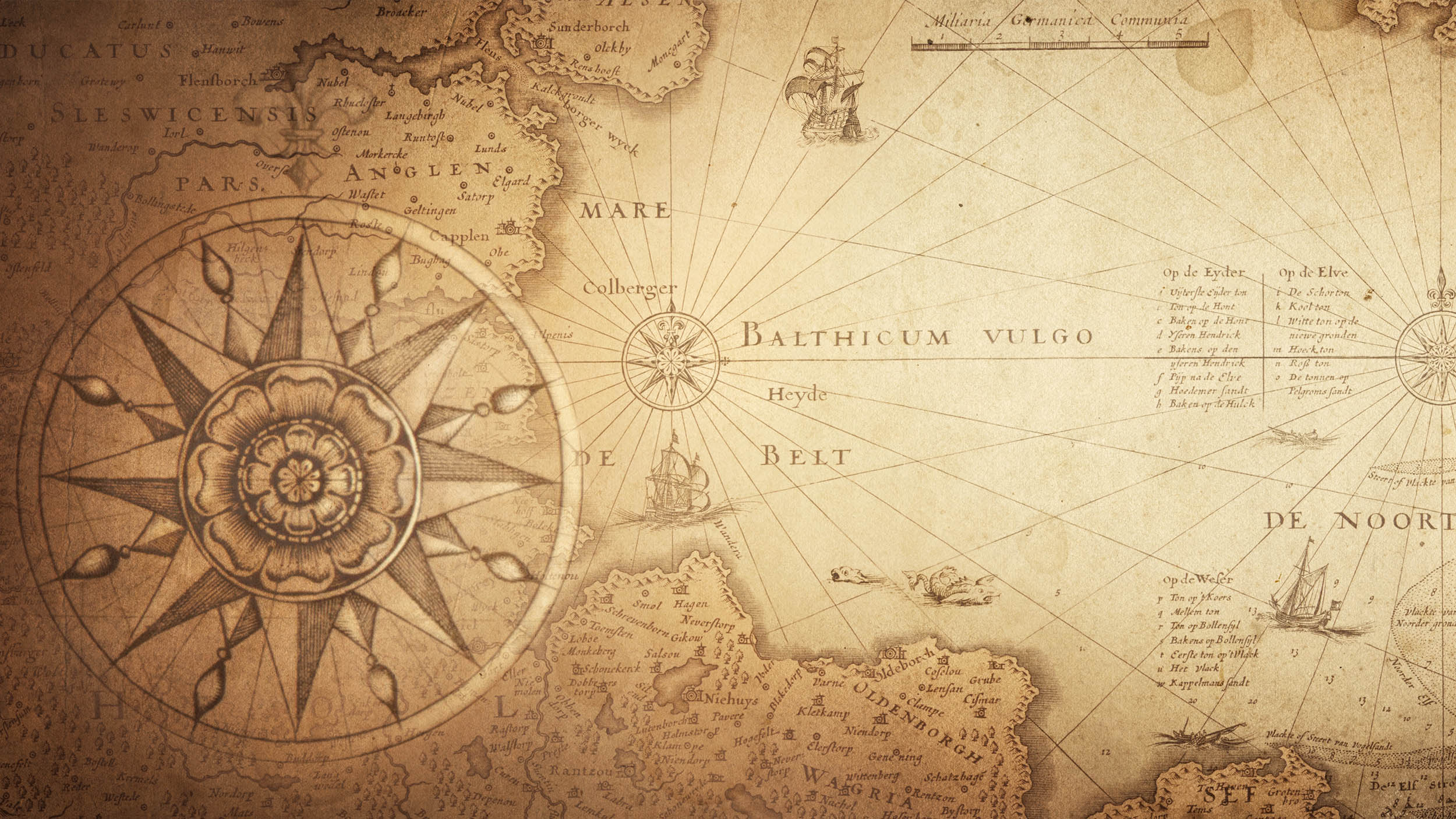Finding accurate navigation at sea has been one of mankind’s toughest nuts to crack. Not so much the direction you’re headed — expert ancient sailors from Phoenicians to Chinese to Polynesians learned fairly early to use the sun, stars, a compass, or all three to get a correct bearing. And determining latitude (how far north or south you are) is a relatively simple matter as well. The length of day or the height of the sun and certain stars above the horizon are handy guides in this department.
But determining how far east or west you are — longitude — is far trickier. Until the 1700s, navigators routinely over- or underestimated their longitude, leading to all kinds of maritime disasters.
In the early 1700s, the burgeoning British Empire took steps to solve the problem. As an island nation, Great Britain was always interested in expanding the frontiers of sea travel, and the thorny longitude issue was the most pressing matter on the agenda.
So, Parliament passed the Longitude Act. It offered a hefty cash prize to anyone who solved the longitude problem.
The race
In doing so, Parliament touched off one of the most fascinating scientific contests in history, on par with the race to the moon. But the race to determine accurate longitude was conducted not by competing governments but by a motley collection of private individuals possessing brilliant brains matched only by outsized personalities.
The following story — as laid down in Dava Sobel’s excellent nonfiction account, Longitude — pits highly educated stargazers and mathematicians against self-taught tinkerers. It spans nearly a half century, ropes in some of the finest minds humanity ever produced, and contains double-crosses, selfishly motivated sabotage, and altruistic genius. Royalty and regular folks, captains and craftsmen, professors and priests all played their part.
Above all, however, the tale of the search for accurate maritime longitude is one of solitary, single-minded obsession.
Enter the clockmaker
John Harrison was born a woodworker but destined to be a clockmaker.
Apprenticed to his carpenter father at an early age, Harrison nevertheless nursed an obsession with timekeeping. He built three clocks in his early adulthood while still working as a carpenter, apparently simply because he could.
The carpentry skills inherited from his father were not wasted. His understanding of materials served him well when he tackled his first major clock-related commission in his early thirties.
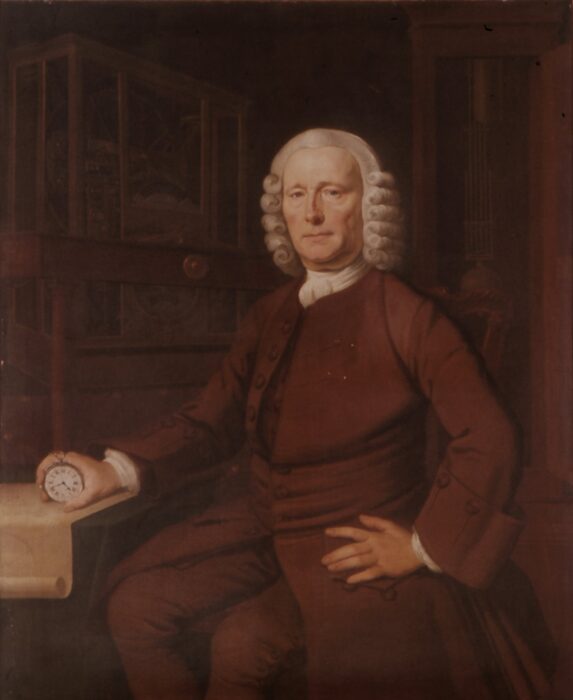
A painting of John Harrison near the end of his life. Painting: Wikimedia Commons
The mechanisms inside the turret clock at Brocklesby Park, North Lincolnshire — which Harrison was commissioned to build in the early 1720s — are entirely made of wood. As such, they don’t require regular lubrication, a common failure point in the clocks of the time. The Brocklesby Park clock also contains another of Harrison’s horological innovations: a grasshopper escapement.
The escapement is the part of a mechanical clock that keeps the pendulum swinging, and friction is every escapement’s enemy. Harrison’s innovation was part design and part material — his grasshopper escapement combines clever engineering with precisely carved wooden workings to virtually eliminate friction in the mechanism.
Other innovations followed, including the grid-iron pendulum. Harrison continued his restless innovation over the years. And as we marvel at his genius, it’s important to remember he had no formal training or apprenticeship as a clockmaker. Like so many luminaries of the Enlightenment era, he simply turned his impressive mind toward a fascinating field, and away he went.
Disaster strikes
Meanwhile, a military disaster provided the impetus for the contest that defined the last fifty years of Harrison’s obsessive life.
On Oct. 22, 1707, four Royal Navy warships ran aground off the Isles of Scilly. Up to 2,000 sailors drowned. The fleet was on the way back from a mission against the French when bad weather caused shipboard navigators to lose track of their position. As was all too common in the era, a shipwreck followed.

An etching of the shipwreck off the Isles of Scilly, one of the greatest maritime disasters in British history. Illustration: Wikimedia Commons
The staggering loss of life, considered by many to be one of the worst maritime accidents ever faced by the British, prompted Parliament into action. A few years later, the lawmaking body passed the Longitude Act of 1714. The legislation offered a hefty cash prize to anyone who could put forth a simple, reliable solution to the longitude problem.
Many great minds across the centuries had already worked on the conundrum. Sir Isaac Newton himself devoted considerable mental energies to it. Considering his interests and fields of study, it’s perhaps inevitable that Newton eventually concluded the answer lay in the clockwork motion of the heavens.
By Harrison’s time, the longitude problem had been boiled down to a deceptively simple concept: comparing accurate local time (determined by observing the high point of the sun on any given day) with the accurate time at a set location. Each hour of difference between the two times equals a 15-degree change in longitude.
But how to determine the time at the set location? That’s the tricky part. The sun moves across the sky from east to west very quickly, so accurate timekeeping is vital.
Longitude methods
As Newton and others rightly concluded, you can measure longitude by calculating the moon’s angle in relation to certain stars (the lunar distance method). You can also achieve the same effect by observing Jupiter’s satellites as they transit the giant gas planet, a method championed by Galileo.
The problem with both methods is that they require time-consuming mathematical calculations on the part of a navigator. They also require thick stacks of astronomical tables created by decades of painstaking astronomical observations, most of which had yet to be conducted in 1714.
In addition to the hefty groundwork and mathematical skills, both the lunar and Jupiter methods require delicate observations with specialized equipment conducted on a rolling ship under clear skies. Any sailor reading this will know how daunting that can be.
Carrying a clock aboard ship — one set to the time of the fixed point — was by far the simplest solution.
Sort of.
Clock method drawbacks
The problem with the clock method is that the clocks of 1714, even the land-based ones, were notoriously unreliable. Put them in a salt-heavy, humid, temperature-fluctuating, constantly rolling environment, and things went even further downhill. Metal parts corroded, lubrication thickened or thinned, mechanisms expanded and contracted, and pendulums swung erratically.
Post 1714, the leading astronomers of the world settled on the lunar distance method, and set about the painstaking, decades-long work of compiling the tables necessary to make the required calculations while aboard ship.
At the same time, Harrison, now with several commissions and a bevy of innovations under his belt, felt he was accomplished enough to solve the existing deficiencies of maritime timekeepers. The race eventually pitted the humble self-taught clockmaker against none other than the Astronomer Royal — the leader of Britain’s prestigious Royal Observatory.
Decades of obsession
By 1730, Harrison had designed a clock he thought could take the prize. He presented his plans to Edmond Halley, the Astronomer Royal at the time. Halley helped Harrison secure funding to create his first sea clock, a process that took five years.
Realizing that a pendulum wouldn’t work at sea, Harrison’s clock (dubbed H1) used two linked dumbbell balances. Harrison also included wooden workings and a version of his grasshopper escapement.
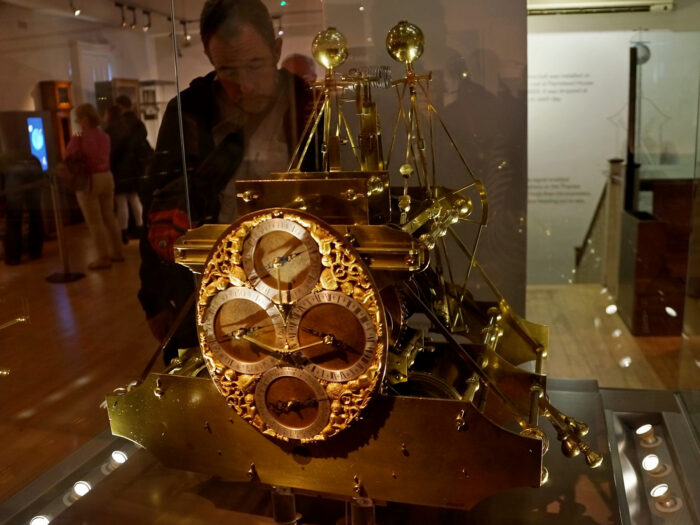
Harrison’s H1 clock at the Royal Museums Greenwich. Photo: Wikimedia Commons
Harrison sailed to Lisbon and back with the H1 in 1736 to test the device. It worked well, but Harrison, as we’ll soon see, was one of history’s most exacting perfectionists. He saw room for improvement, as did the Longitude Board. Nevertheless, the H1 impressed the Board enough for it to grant Harrison funding for a second version.
The H2 took another five years to complete — three years of construction and two years of land-based testing. It was ready to go in 1741, by which time Britain was at war with Spain. The powers that be determined that the H2 was too valuable to fall into Spanish hands, so a sea-based test was postponed.
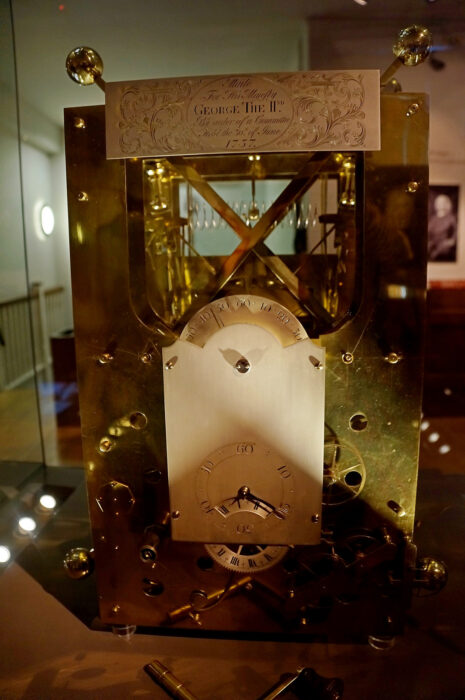
Harrison’s H2 clock at the Royal Museums Greenwich. Photo: Wikimedia Commons
Another 17 years, another timepiece
By the time the war ended, Harrison’s precise mind had abandoned the H2 and was already at work on the H3, this time incorporating new advances to compensate for the yawing action of ships.
Completing the H3 took Harrison an incredible 17 years.
Along the way, Harrison adapted his bi-metallic pendulum concept into the bi-metallic strip — fusing two pieces of metal together in strategic locations within the clock to compensate for the change of temperature commonly found on sailing vessels. He also invented the caged roller bearing, which further decreased friction within his device. Caged roller bearings are still in use today.
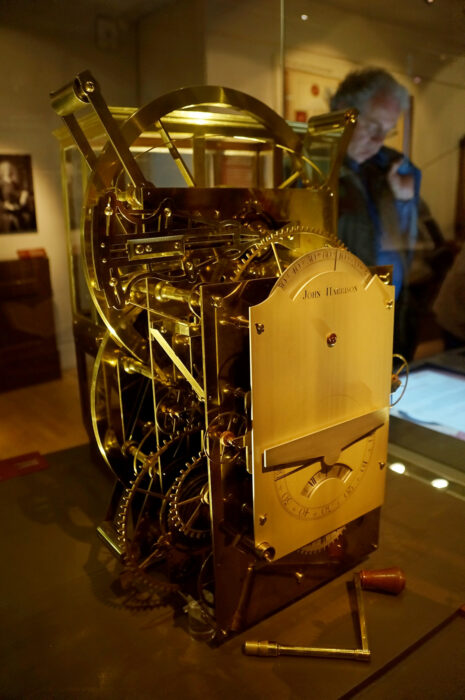
Harrison’s H3 clock at the Royal Museums Greenwich. Photo: Wikimedia Commons
Perhaps even more importantly, the nearly two decades of work on the H3, along with advances made by other clockmakers during those years, convinced Harrison that his large and unwieldy devices could be shrunk to pocket watch size. The clock that became Harrison’s masterstroke, the H4, was ready for sea testing in 1759, six years after Harrison began work on it.
All of Harrison’s clocks are beautiful in their functionality, but the H4 outshines them all. Constructed of, among other things, brass and diamonds, it was as lovely as it was effective. In addition to being the most accurate of all Harrison’s marine clocks, it also contained technology that kept it running as it was being wound — another of Harrison’s endless innovations.
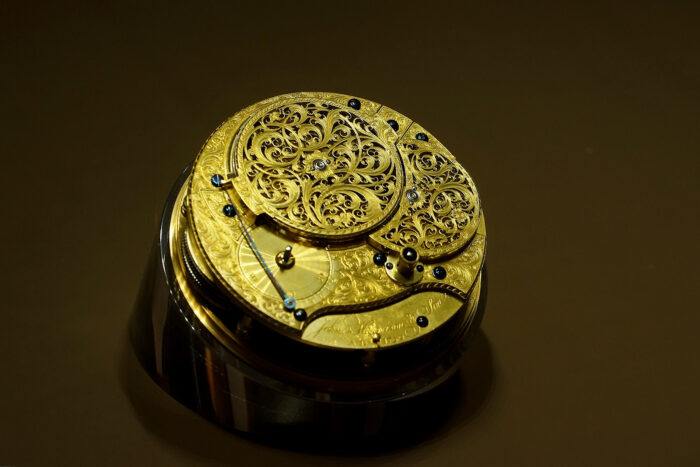
Harrison’s H4 clock at the Royal Museums Greenwich. Photo: Wikimedia Commons
The rival
Now, all that was required was to send the H4 on a successful sea voyage, and then the prize money would finally be his.
But during the long years between 1714 and 1759, astronomers intent on proving the lunar distance method’s viability were busy. Observations had been made, tables compiled, and tests conducted.
By then, the Royal Astronomer was Reverand Nevil Maskelyne. He was a huge proponent of the lunar method and had worked for years to prove its efficacy. As the Royal Astronomer, he sat on the Longitude Board, and he would use his considerable sway to make Harrison’s life utterly miserable moving forward.
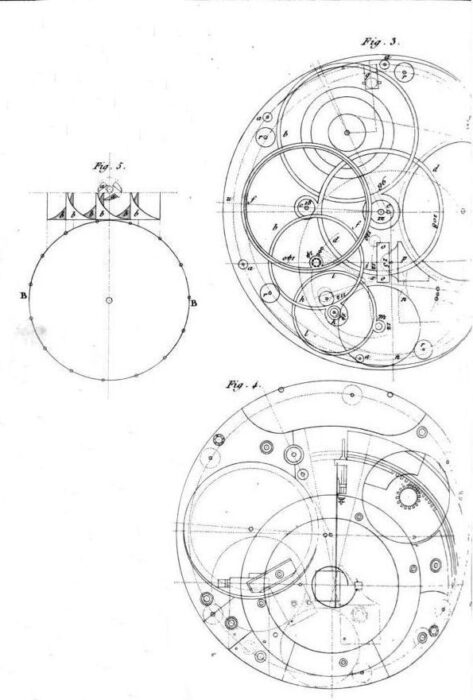
Harrison’s plans for the H4. Illustration: Wikimedia Commons
Complicated tests
The Board of Longitude demanded a series of increasingly detailed and complicated sea tests for the H4. Harrison’s son accompanied the H4 on these tests, as Harrison himself was aging and his eyesight was beginning to fail. The H4 received acclaim from captains and navigators aboard every ship upon which it sailed. It was accurate within one nautical mile, while tests of the lunar distance method conducted by Maskelyne were only accurate to within 30 nautical miles.
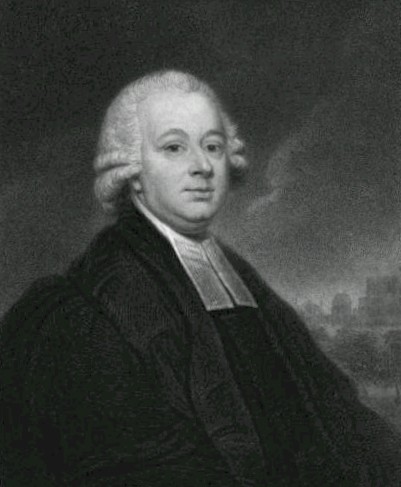
Reverend Nevil Maskelyne, the astronomer who plagued Harrison during the race for accurate longitude at sea. Illustration: Wikimedia Commons
Still, Maskelyne convinced the Board that the H4’s accuracy was a fluke and that the device was too expensive and complicated for mass production. At Maskelyne’s urging, the Board insisted on confiscating the H1, H2, H3, and H4 for study, as well as all of Harrison’s plans, notes, and diagrams of the various sea clocks. Maskelyne himself showed up at Harrison’s house with a warrant for the devices, and it’s perhaps no accident that the H1 was dropped and damaged during transport.
Harrison reluctantly agreed and settled in to wait on his prize money.
The King steps in
Months, then years, went by with no word from the Board. It appeared as if one well-placed astronomer would stop the burgeoning clock-based longitude method in its tracks.
But Harrison was nothing if not a manic tinkerer, and during the Board’s endless testing and dithering, the aging clockmaker was hard at work on the H5. With a new pocket watch in hand, Harrison and his son were able to enlist help from an unlikely source — the King of England.
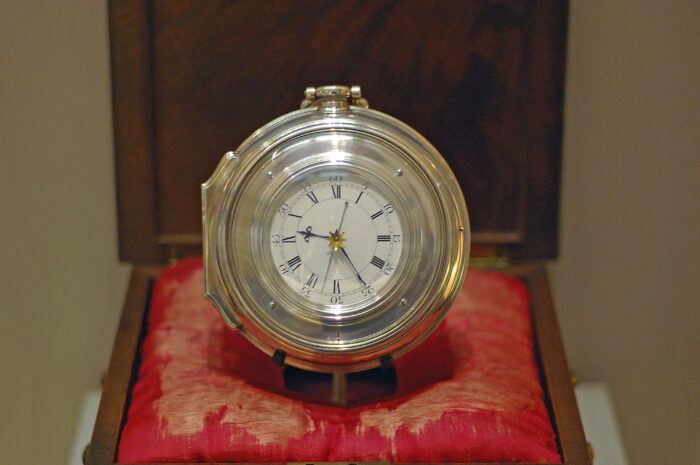
Harrison’s H5, the version he showed to King George III
While American readers mostly know King George III from his actions before, during, and after the Revolutionary War, the King had a burning interest in science and often employed private tutors to expand his knowledge.
The Harrisons secured an audience with the King in 1772. By now, the elder Harrison was 79.
King George III was outraged at Harrison’s treatment by Parliament and the Board, and he tested the watch himself over several months in 1772. The impressed monarch sent word to Parliament, threatening to appear in person to read them the riot act, then encouraged Harrison to appeal to the body one final time.
With royal pressure bearing down, Parliament finally relented and awarded Harrison a lump sum of £8,750, less than half of the £20,000 originally promised by the Longitude Act of 1714. But combined with disbursements Harrison secured over the course of his forty-year quest to build a functional sea clock, his total payments equaled roughly £23,065.
Endings and beginnings
Maskelyne continued as Astronomer Royal until his death in 1811 and championed the lunar method until his dying day. He published the British Nautical Almanac and Astronomical Ephemeris for the Meridian of the Royal Observatory at Greenwich, which contained a full set of tables for determining longitude by the lunar distance method. With the Almanac and increasingly sophisticated equipment, the lunar distance method finally became a viable option for mariners, though it still required considerable time and effort to make accurate determinations.
Unrepentant to the last, Maskelyne never expressed remorse for his role in squelching the viability of Harrison’s clocks. In fact, after the day when the Reverend showed up at Harrison’s door and demanded the devices, the two men never spoke again.
Harrison died in 1776, so he never lived to see his work gradually supplant the more labor-intensive lunar distance method. While the sums he received made him a wealthy man by that era’s standards, he was frustrated, exhausted, and embittered by the entire process by the time he died.
But eventually, he was vindicated.
Other clockmakers standing on Harrison’s shoulders found ways to simplify the mechanisms and cut production costs, reducing the burden for seafarers forced to buy their own navigational equipment. As the 19th century dawned, versions of Harrison’s clocks and others based on his work gradually found their way into the hands of navigators the world over.
Harrison wins the long game
Captain Cook and other famous explorers eventually began using some form of sea clock to determine longitude, using lunar distance merely as a backup. In time, sea clocks, or chronometers as they came to be called, became every captain’s method for determining longitude at sea. Mechanical marine chronometers remained in widespread use well through the 20th century.
Moreover, Harrison’s contributions to the world of timekeeping are almost too staggering to be believed. Few other private citizens have made such leaping advancements in their field in such a relatively short time under such circumstances. It would be as if Robert Oppenheimer or Wernher von Braun conducted their research not as university or government employees but in the back room of a little shop, occasionally supplemented by drips of funding.
Today, the H1, H2, H3, and H4 are available for viewing at the Royal Museums Greenwich. A few of them are still running, a testament to one humble Yorkshire-born carpenter’s lifelong dedication to a single scientific problem.
We’ll never know what Harrison would think of his life’s work being housed at the museum of the very institution that denied him his well-deserved fame and prize money.
But it’s likely that if Harrison were standing in the display room, peering through the glass cases at his marvelous clocks, he’d waste no time in pulling out a notebook, borrowing a pen, and scuttling off to a quiet corner to begin work on yet another.
